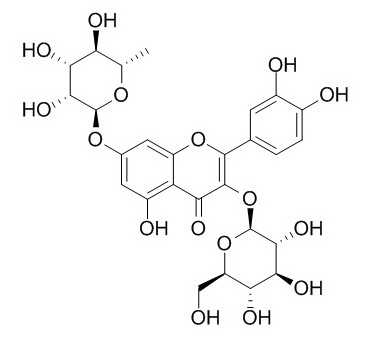Quercetin 3-O-glucoside-7-O-rhamnoside
Quercetin 3-O-glucoside-7-O-rhamnoside at 30 mg/kg i.p. can decrease the ambulatory locomotor activity and increase the sodium thiopental-induced time of loss of the righting reflex suggesting a clear depressant action.
Inquire / Order:
manager@chemfaces.com
Technical Inquiries:
service@chemfaces.com
Tel:
+86-27-84237783
Fax:
+86-27-84254680
Address:
1 Building, No. 83, CheCheng Rd., Wuhan Economic and Technological Development Zone, Wuhan, Hubei 430056, PRC
Providing storage is as stated on the product vial and the vial is kept tightly sealed, the product can be stored for up to
24 months(2-8C).
Wherever possible, you should prepare and use solutions on the same day. However, if you need to make up stock solutions in advance, we recommend that you store the solution as aliquots in tightly sealed vials at -20C. Generally, these will be useable for up to two weeks. Before use, and prior to opening the vial we recommend that you allow your product to equilibrate to room temperature for at least 1 hour.
Need more advice on solubility, usage and handling? Please email to: service@chemfaces.com
The packaging of the product may have turned upside down during transportation, resulting in the natural compounds adhering to the neck or cap of the vial. take the vial out of its packaging and gently shake to let the compounds fall to the bottom of the vial. for liquid products, centrifuge at 200-500 RPM to gather the liquid at the bottom of the vial. try to avoid loss or contamination during handling.
Journal of Chromatography A2020, 460942
J Clin Med.2019, 8(10):E1664
Chinese Pharmacological Bulletin2019, 35(8):1120-1125
LWT2021, 138:110630.
Nutrients.2020, 12(11):3448.
J Ethnopharmacol.2018, 210:88-94
Appl. Sci.2020, 10,1304
Cosmetics2025, 12(3), 108
Korean Journal of Medicinal Crop Science2018, 26(5):382-390
Research on Crops.2017, 18(3):569
Related and Featured Products
Phytother Res. 2009 Oct;23(10):1453-7.
Neuroactive flavonoid glycosides from Tilia petiolaris DC. extracts.[Pubmed:
19288528]
Pharmacological assay guided purification of an ethanol extract of Tilia petiolaris DC. inflorescences resulted in the isolation and identification of isoquercitrin (ISO), Quercetin 3-O-glucoside-7-O-rhamnoside (QUE) and kaempferol 3-O-glucoside-7-O-rhamnoside (KAE).
METHODS AND RESULTS:
The behavioral actions of these glycosylated flavonoids were examined in the hole board, locomotor activity and thiopental-induced loss of righting reflex tests in mice. Quercetin 3-O-glucoside-7-O-rhamnoside (10 and 30 mg/kg) and KAE (30 mg/kg), intraperitoneally (i.p.) administered to mice, reduced all the parameters measured in the hole board test, but ISO (30 mg/kg) only reduced the number of rearings. Meanwhile Quercetin 3-O-glucoside-7-O-rhamnoside at 30 mg/kg i.p. also decreased the ambulatory locomotor activity and increased the sodium thiopental-induced time of loss of the righting reflex suggesting a clear depressant action.
CONCLUSIONS:
The above results demonstrate the occurrence of neuroactive flavonoid glycosides in Tilia.
Appl Microbiol Biotechnol. 2013 Jun;97(12):5275-82.
Regioselective synthesis of flavonoid bisglycosides using Escherichia coli harboring two glycosyltransferases.[Pubmed:
23549747 ]
Regioselective glycosylation of flavonoids cannot be easily achieved due to the presence of several hydroxyl groups in flavonoids.
METHODS AND RESULTS:
This hurdle could be overcome by employing uridine diphosphate-dependent glycosyltransferases (UGTs), which use nucleotide sugars as sugar donors and diverse compounds including flavonoids as sugar acceptors. Quercetin rhamnosides contain antiviral activity. Two quercetin diglycosides, Quercetin 3-O-glucoside-7-O-rhamnoside and quercetin 3,7-O-bisrhamnoside, were synthesized using Escherichia coli expressing two UGTs. For the synthesis of Quercetin 3-O-glucoside-7-O-rhamnoside, AtUGT78D2, which transfers glucose from UDP-glucose to the 3-hydroxyl group of quercetin, and AtUGT89C1, which transfers rhamnose from UDP-rhamnose to the 7-hydroxyl group of quercetin 3-O-glucoside, were transformed into E. coli. Using this approach, 67 mg/L of Quercetin 3-O-glucoside-7-O-rhamnoside was synthesized. For the synthesis of quercetin 3,7-O-bisrhamnoside, AtUGT78D1, which transfers rhamnose to the 3-hydroxy group of quercetin, and AtUGT89C1 were used.
CONCLUSIONS:
The RHM2 gene from Arabidopsis thaliana was coexpressed to supply the sugar donor, UDP-rhamnose. E. coli expressing AtUGT78D1, AtUGT89C1, and RHM2 was used to obtain 67.4 mg/L of quercetin 3,7-O-bisrhamnoside.



